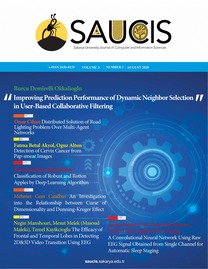The Data Science Met with the COVID-19: Revealing the Most Critical Measures Taken for the COVID-19 Pandemic
___
[1] N. Zhu et al., “A novel coronavirus from patients with pneumonia in China, 2019,” N. Engl. J. Med., vol. 382, pp. 727–733, 2020, doi: 10.1056/NEJMoa2001017.[2] J. F. W. Chan et al., “A familial cluster of pneumonia associated with the 2019 novel coronavirus indicating person-to-person transmission: a study of a family cluster,” Lancet, vol. 395, pp. 514– 523, 2020, doi: 10.1016/S0140-6736(20)30154-9.
[3] “COVID-19 CORONAVIRUS PANDEMIC,” Worldometer, 2020. https://www.worldometers.info/coronavirus/ (accessed May 05, 2020).
[4] A. Wilder-Smith and D. O. Freedman, “Isolation, quarantine, social distancing and community containment: Pivotal role for old-style public health measures in the novel coronavirus (2019- nCoV) outbreak,” J. Travel Med., vol. 27, no. 2, pp. 1–4, 2020, doi: 10.1093/jtm/taaa020.
[5] X. Jiang et al., “Towards an Artificial Intelligence Framework for Data-Driven Prediction of Coronavirus Clinical Severity,” Comput. Mater. Contin., vol. 63, no. 1, pp. 537–551, 2020, doi: 10.32604/cmc.2020.010691.
[6] A. Strzelecki and M. Rizun, “Infodemiological Study Using Google Trends on Coronavirus Epidemic in Wuhan, China,” Int. J. Online Biomed. Eng., vol. 16, no. 4, pp. 139–146, 2020, doi: 10.3991/ijoe.v16i04.13531.
[7] “Google Trends,” Google, 2020. https://trends.google.com/trends (accessed Aug. 02, 2020).
[8] M. Fang et al., “CT radiomics can help screen the Coronavirus disease 2019 (COVID-19): a preliminary study,” Sci. China Inf. Sci., vol. 63, no. 7, pp. 1–8, 2020, doi: 10.1007/s11432-020- 2849-3.
[9] E. Dong, H. Du, and L. Gardner, “An interactive web-based dashboard to track COVID-19 in real time,” Lancet Infect. Dis., 2020, doi: 10.1016/S1473-3099(20)30120-1.
[10] “Novel Coronavirus (COVID-19) Cases, provided by JHU CSSE,” Johns Hopkins University, 2020. https://github.com/CSSEGISandData/COVID-19 (accessed May 05, 2020).
[11] “pandas: Python Data Analysis Library,” 2020. https://pandas.pydata.org (accessed May 05, 2020).
[12] P. Chandro, “porimol/countryinfo: A Python module for returning data about countries, ISO info and states/provinces within them,” 2019. https://github.com/porimol/countryinfo (accessed May 05, 2020).
[13] “COVID ‑- 19 Mobility Trends Reports - Apple,” Apple, 2020. https://www.apple.com/covid19/mobility (accessed May 05, 2020).
[14] “Countries by Population Density 2020 - StatisticsTimes.com,” StatisticsTimes.com, 2020. http://statisticstimes.com/demographics/countries-by-population-density.php (accessed May 05, 2020).
[15] J. Papastylianou, “COVID-19 Lockdown dates by country | Kaggle,” 2020. https://www.kaggle.com/jcyzag/covid19-lockdown-dates-by-country (accessed May 05, 2020).
[16] F. Pedregosa et al., “Scikit-learn: Machine Learning in Python,” J. Mach. Learn. Res., vol. 12, pp. 2825–2830, 2011.
[17] H. U. Zacharias, M. Altenbuchinger, and W. Gronwald, “Statistical Analysis of NMR Metabolic Fingerprints: Established Methods and Recent Advances,” Metabolites, vol. 8, no. 3, pp. 1–10, 2018, doi: 10.3390/metabo8030047.
[18] S. C. Nayak, B. B. Misra, and H. S. Behera, “Impact of Data Normalization on Stock Index Forecasting,” Int. J. Comput. Inf. Syst. Ind. Manag. Appl., vol. 6, pp. 257–269, 2014.
[19] A. Zien, N. Krämer, S. Sonnenburg, and G. Rätsch, “The Feature Importance Ranking Measure,” in The European Conference on Machine Learning and Principles and Practice of Knowledge Discovery in Databases (ECML PKDD 2009), 2009, pp. 694–709, doi: 10.1007/978-3-642- 04174-7_45.
[20] K. B. Prakash, S. S. Imambi, M. Ismail, T. Pavan Kumar, and Y. V. R. Naga Pawan, “Analysis, Prediction and Evaluation of COVID-19 Datasets using Machine Learning Algorithms,” Int. J. Emerg. Trends Eng. Res., vol. 8, no. 5, pp. 2199–2204, 2020, doi: 10.30534/ijeter/2020/117852020.
[21] A. K. M. B. Haque, T. H. Pranto, A. A. Noman, and A. Mahmood, “Insight about Detection, Prediction and Weather Impact of Coronavirus (COVID-19) using Neural Network,” Int. J. Artif. Intell. Appl., vol. 11, no. 4, pp. 67–81, 2020, doi: 10.5121/ijaia.2020.11406.
[22] S. Patil, A. Patil, and V. M. Phalle, “Life Prediction of Bearing by Using Adaboost Regressor,” in Proceedings of the TRIBOINDIA-2018 An International Conference on Tribology, 2018, pp. 1–8, doi: 10.2139/ssrn.3398399.
[23] S. Patil, S. Desai, A. Patil, V. M. Phalle, V. Handikherkar, and F. S. Kazi, “Remaining Useful Life (RUL) Prediction of Rolling Element Bearing Using Random Forest and Gradient Boosting Technique,” in Proceedings of the ASME International Mechanical Engineering Congress and Exposition, Proceedings (IMECE 2018), 2018, pp. 1–7, doi: 10.1115/IMECE2018-87623.
[24] V. C. C. Cheng et al., “Escalating infection control response to the rapidly evolving epidemiology of the Coronavirus disease 2019 (COVID-19) due to SARS-CoV-2 in Hong Kong,” Infect. Control Hosp. Epidemiol., pp. 1–6, 2020, doi: 10.1017/ice.2020.58.
[25] “Rational use of personal protective equipment for coronavirus disease 2019 (COVID-19),” World Health Organization (WHO). pp. 1–7, 2020.
[26] M. Lazzerini and G. Putoto, “COVID-19 in Italy: momentous decisions and many uncertainties,” Lancet Glob. Heal., vol. 8, no. 5, pp. e641–e642, 2020, doi: 10.1016/S2214-109X(20)30110-8.
- ISSN: 2636-8129
- Yayın Aralığı: Yılda 3 Sayı
- Başlangıç: 2018
An Evaluation of VGG16 Binary Classifier Deep Neural Network for Noise and Blur Corrupted Images
Identification of Plant Species by Deep Learning and Providing as A Mobile Application
Normal Cumulative Distribution Function and Dispersion Entropy Based EMG Classification
A New Hybrid Filter Approach for Image Processing
Bekir AKSOY, Osamah Khaled Musleh SALMAN
Review on Bitcoin Price Prediction Using Machine Learning and Statistical Methods
I.Sibel KERVANCI, Mehmet Fatih AKAY
Adding Virtual Objects to Realtime Face Images; A Case Study in Augmented Reality
Automatic Olive Peacock Spot Disease Recognition System Development by Using Single Shot Detector
A Comparison of the State-of-the-Art Deep Learning Platforms: An Experimental Study
Sentiment Analysis for Software Engineering Domain in Turkish
